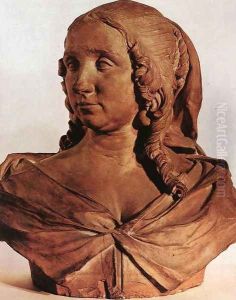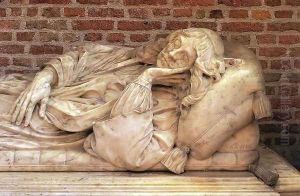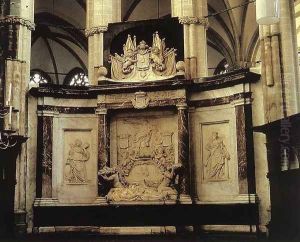Rombout Verhulst Paintings
Rombout Verhulst was a Flemish sculptor who is considered one of the leading figures in Baroque sculpture in the Dutch Golden Age. Born in Mechelen, present-day Belgium, in 1624, Verhulst's work exemplifies the transition from the Flemish Baroque tradition to the more restrained Dutch classicism, reflecting a blend of both dynamism and detail with a sense of calm and simplicity. His career is a testament to the cultural exchanges between the Southern and Northern Netherlands during the 17th century, a period marked by significant political, religious, and social upheavals.
Verhulst moved to the Northern Netherlands in the mid-17th century, where he worked extensively, contributing to the development of Dutch sculpture. Unlike many of his contemporaries who primarily focused on painting—the dominant medium of the time—Verhulst dedicated himself to the art of sculpture, creating works in marble, stone, and wood. He is particularly renowned for his funerary monuments and portrait busts, which display a meticulous attention to detail and a profound understanding of human anatomy and emotions. His sculptures often feature serene faces, elegantly draped garments, and intricate decorations, all of which are characteristic of his refined and graceful style.
Among his most famous works are the tomb of William the Silent in the Nieuwe Kerk in Delft and the funerary monuments for the Admirals Michiel de Ruyter and Maerten Tromp. These works not only showcase his skill as a sculptor but also serve as important historical documents, commemorating the lives of some of the most significant figures in Dutch history. Verhulst's ability to capture the dignity and solemnity of his subjects without sacrificing the warmth and vitality that characterized his style has earned him a lasting place in the annals of art history.
Rombout Verhulst's contributions to Dutch sculpture were profound and enduring. His work bridged the gap between the exuberant Baroque style of his Flemish roots and the more restrained classicism that came to define Dutch art in the latter half of the 17th century. He passed away in 1698, leaving behind a legacy that would influence generations of sculptors. Today, his works are celebrated for their beauty, technical mastery, and historical significance, making him one of the most respected sculptors of his time.


